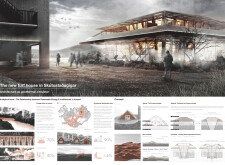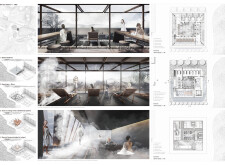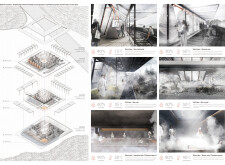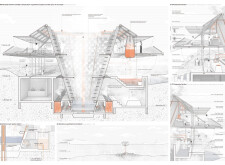5 key facts about this project
## Overview
The Turf House, located in Skútustaðagígar, Iceland, represents a contemporary interpretation of traditional Icelandic turf architecture, emphasizing the effective integration of geothermal energy management. Situated in a geothermal-rich region, the design caters to recreational and educational activities while promoting sustainability. The project seeks to redefine the principles of energy efficiency and user engagement, creating a facility that connects visitors with Iceland's natural resources.
## Geothermal Integration
The architectural design utilizes geothermal energy as a central element, reflecting the prevalent energy practices in Iceland where the majority of residential heating relies on this resource. The Turf House functions as a circulator of geothermal energy, employing a cooling tower system to optimize the indoor microclimate through the manipulation of natural heat and humidity. This design approach not only achieves thermal comfort but also enhances the overall experiential quality for users, promoting interaction with the surrounding environment.
## Material Selection
Materials selected for the Turf House are integral to both its functionality and aesthetic coherence. Traditional turf serves as insulation, connecting the structure to Iceland's architectural heritage. Wood is extensively used for its warmth and thermal properties, while stone provides durability and thermal mass, further benefitting the building's geothermal systems. Copper is utilized for plumbing, contributing to the overall structural integrity, and glass elements are incorporated to enhance natural lighting and visual links to the landscape while maintaining thermal efficiency through advanced glazing techniques.
## Spatial Configuration
The unique spatial organization of the Turf House creates distinct zones for various activities, including a beer tasting bar, a beer spa, and an operational brewery area. Each section is designed to encourage interaction and facilitate educational experiences related to Icelandic brewing traditions, alongside wellness facilities that utilize geothermal steam for therapeutic benefits. This configuration not only supports diverse user activities but also fosters a communal environment that enhances the visitor experience.
## Environmental Context
The design respects and responds to the natural terrain of Skútustaðagígar, with features such as a "heavy layer" of stone that integrates the building into the landscape. This strategy creates a dialogue between the architectural form and its environment, underscoring the commitment to sustainability and minimizing the ecological footprint. The building systems are meticulously designed to optimize energy use and comfort, ensuring effective temperature and humidity regulation while emphasizing a circular approach to resource management.





















































